Motion to Deem Facts Admitted
If a party fails to respond to a Request for Admissions entirely, the party who served the Request for Admissions is entitled to a court order deeming each of the facts listed in the Request for Admissions to be true, and each document listed in the Request to be deemed genuine. The judge is also required to order that the responding party to pay the costs of filing the motion. This is called “imposing monetary sanctions.”
Templates and Forms
- Motion to Deem Facts Admitted Template – RTF
- Proof of Personal Service – Personal (POS-020)
- Proof of Personal Service – Mail (POS-030)
During discovery, each party may serve one or more sets of Requests for Admissions, asking the opposing side to admit that
- that one or more facts are true or
- one or more documents are genuine.
If a party admits a fact, or admits that a document is genuine, that fact, or the genuineness of the document, does not need to be proven at trial.
If a motion to deem the admissions admitted is filed, the responding party can prevent his or her admissions being deemed true by serving adequate responses prior to the hearing date of the motion. Generally the responding party still must pay the sanction.
Note: even if your motion is granted, it may be possible for the party whose admissions were deemed admitted to file a Motion for Relief from Admissions under certain circumstances. For more information on this process, see our guide to Motion for Relief from Admissions.
Unless a successful Motion for Relief from Admissions is filed, any admissions deemed admitted must be considered true by the court or jury, and the party whose admissions were deemed admitted will be prevented from presenting evidence inconsistent with the admitted facts at trial.
Related Discovery Guides
Requests for Admissions are unique
Requests for Admissions are the only type of discovery with this “motion to deem” remedy.
If a party fails to respond to interrogatories or requests for production, the requesting party files a Motion to Compel Discovery Responses. For help with or more information on these types of motions, see the resources listed at the end of this Guide.
Also attached to this guide is a sample motion asking a court to issue an order that the court deem each statement in a Request for Admissions to be true, and for monetary sanctions in the amount of the motion fee and any attorney fees for filing the motion. Self-represented litigants in Sacramento may only receive attorney fees if they actually hired an attorney to work in any capacity on the motion.
Step by Step Instructions
1
Schedule the Hearing
This information is for Sacramento. If your case is in a different county, do not follow these instructions. Instead, call the clerk or visit the court website in your county to find the correct information.
Determine the department and time of the motion
In Sacramento, most motions are heard in the “Civil Home Court” department assigned to the case, which will be either department 25, 28, 53, or 54. Check your case file online to find which department your case is assigned to.
Note: Prior to November 10, 2025, each civil case was assigned to either Department 53 or 54 for most motions. If your case was filed before that date, its assigned department may have changed, so check before scheduling a hearing.
More information about Civil Home Court department transition
A few types of motions are heard in other departments. Check which departments hear which types of motions in Sacramento on the Civil Motions webpage.
Reserve the date for the hearing
In the Civil Home Departments, you must reserve a court date through the court’s online reservation system. For other departments, contact the department clerk to determine the procedure.
To use the online system, go to the Sacramento Court Public Portal and choose “Reservation System (CRS).” You must have a free account on the system to use it.
Before you log on or call, figure out if there are any days you will not be available during the next couple of months. For instance, you don’t want to pick a date when you know you will be out of town.
You must choose a date far enough in the future that you can both file and serve your motion on time. Scheduling it four weeks in advance generally gives a comfortable margin for most types of motions. Usually, the first available date will be further away than that.
Determine the legal deadline to file the motion in court
Disclaimer! Some motions have different time requirements. Check the rules for the motion you are filing.
Tip: File the motion as soon as possible. Your reservation is not final until the motion has been filed and any fees paid.
The last legal day to file with the court is at least sixteen court (business) days prior to the motion date (CCP § 1005). “Court days” are Monday through Friday, excluding court holidays.
NOTE: the court must receive the documents by that day. Postmark will not count.
To determine whether a particular filing date will meet this deadline, start counting backwards on the day before your hearing until you reach the sixteenth court day. (CCP § 12c)
For example, suppose your reservation is for Monday, June 18. You would start counting backward using the previous court day, Friday, June 15, as day one, as shown in the calendar below. Skip weekends and court holidays (there is one court holiday in this example, which is Memorial Day, May 28). The sixteenth court day before the hearing would be May 24, which would be the last day that the motion could be filed.
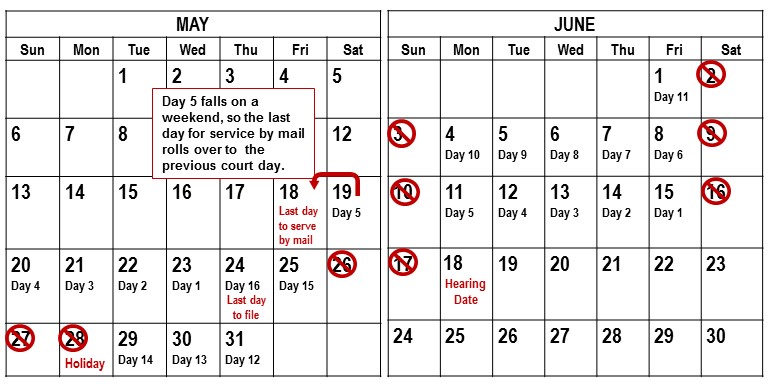
Make a note on your calendar to file the motion by this date. Do not miss this deadline. The court will cancel the hearing and you will have to start over.
Determine the legal deadline to serve the motion on the other parties or their attorneys
You must have a copy of the motion served on all other attorneys (or self-represented parties) by a strict deadline set by law. Earlier is always fine.
Personal service: 16 court days before the hearing, the same as the minimum filing deadline. The server should fill out Proof of Personal Service—Civil (POS-020).
Service by mail: 16 court days before hearing PLUS five calendar days before the hearing (more if the mailing address is outside California). (CCP § 1005). The server should fill out Proof of Service by First-Class Mail—Civil.
“Court days” are business days – Monday – Friday, except holidays.
“Calendar days” include weekends and holidays, but if the final day lands on a weekend or holiday, it is pushed back to the previous court day.
Make a note on your calendar to have the motion served by mail before the mail deadline. If you miss the mail deadline, you can still have the motion served by personal service up until 16 court days before the hearing. If you miss that deadline, you will have to cancel your court date and start over.
2
Prepare the Motion
There is no pre-printed form for this motion. You will need to customize a motion on “pleading paper.” Instructions and a sample motion are at the end of this guide.
Parts of a Motion
A request to deem an opposing party’s admissions true is made through a motion. A motion is a request to the judge to issue an order of some sort.
A written motion consists of four parts (the Notice of Motion and Motion are combined):
- Notice of Motion and Motion;
- Points and Authorities; and
- Declaration
The Notice of Motion lets the opposing party know when and where the motion is scheduled to be heard, while the Motion lets the court and the opposing party know what is being requested. The Points and Authorities explains to the court and the opposing party the legal basis of the motion, while the Declaration provides evidence, sworn under penalty of perjury, supporting the motion.
The parts can be filed as separate documents or combined into one document, as in our template motion.
Modify the Template Motion
There is no Judicial Council form for this procedure. Instead, the relevant documents must be typed on 28-line pleading paper. A customizable template may be downloaded from this link:
More information about how to fill the forms out is included on the sample at the end of this guide.
Include Request for Admissions with its Proof of Service in your Declaration: All Motions to Deem Facts Admitted must include a copy of the Request for Admissions (including the signed Proof of Service demonstrating the date and method the Request for Admissions was served on the responding party). You may need additional exhibits depending on your situation.
4
Have Your Documents Served on the Attorney(s) or Self-Represented Party(s)
You must have someone serve your papers on the other attorney or self-represented party in the case. (If there are more than two parties, you must serve all parties, or their attorneys if they have one).
Service must be complete 16 court (business) days before the hearing date, plus five calendar days if you have it served by mail.
Tip: If the mailing deadline (16+5 days) has passed, but there are still more than 16 court days before the hearing, you can have it served by personal delivery. If you miss the service deadline entirely, you will need to re-schedule your motion.
Proof of Service form:
After service is done, you will need to file a Proof of Service signed by the server. If serving by mail, you can use Proof of Service by Mail (POS-030). For personal service, use Proof of Personal Service (POS-020). You can fill most of the Proof of Service out now, but it should not be signed. Make a copy of the unsigned proof of service before proceeding and include it with the motion papers when you have them served.
After serving the papers, your server will sign the Proof of Service form, and give it to you.
Attach the original signed Proof of Service to your original signed motion. If you are using an optional copy for yourself, attach a copy of the Proof of Services to that.
You can also file it as a separate document, without attaching it to your motion papers.
5
Assemble your Documents for Filing
Assemble your packet for filing as follows. The original should be unstapled, while any copy is stapled.
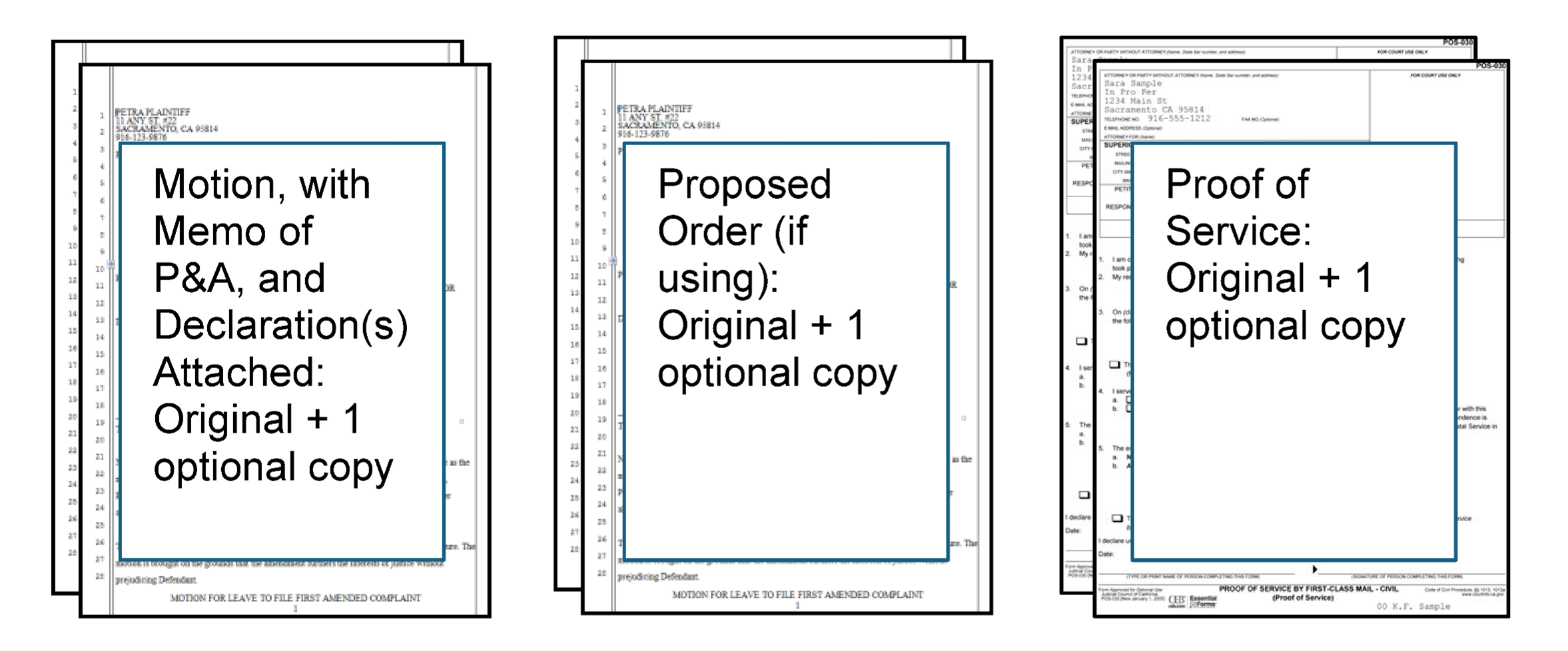
- Motion, including Memorandum of Points and Authorities and Declaration with exhibits: original plus one optional copy to be returned to you.
- Proposed Order, if included, plus one optional copy.
- Completed Proof of Service form: The original plus plus one optional copy. This proof of service can filed as its own document, or it can be attached as the last page of the Motion when filing. If it is attached, then attach the original signed Proof of Service to the original signed Motion.
- Any other documents, such as Request for Judicial Notice, should be treated the same way: create a stack of original plus one optional copy and file along with the others.
If you are submitting the papers in the dropbox, you will find cover sheets and large binder clips to hold the whole package together near the box.
6
File at the Hall of Justice Building
File your motion, along with fees if needed, at at the Hall of Justice building, 813 6th St. (6th and H). Your options are:
- Wait in line to file with the clerk in Room 212.
- Drop your paperwork and payment (check or money order only) in the dropbox in the lobby. Your papers will be marked as filed on the day you place them in the box if they arrive before 5 p.m.
- Mail your paperwork and payment to: 720 9th St., Rm 102, Sacramento CA 95814. Payment must be by check or money order. Your papers must arrive by the due date; the postmark will be ignored.
- Use the court’s efiling system. This system is optional for self-represented litigants. Fees will be paid to the electronic filing service provider, which forwards them to the court.
At this time there is a $60 filing fee for a motion, unless your fees were waived. Dropbox filings must include a check or money order/cashiers check, no credit cards. Credit cards can be accepted at the counter or used when efiling.
Fee Waiver: If you are receiving government benefits such as Medi-Cal or are otherwise qualified because of low income, you can apply for a fee waiver. If you do not yet have a fee waiver, turn the fee waiver request forms in with the motion instead of a fee payment. For more information, see our Step-by-Step guide on Fee Waivers.
6
The Other Party Can Serve Proposed Responses and Defeat the Motion
If the other party serves proper responses without objections prior to your hearing, the court cannot grant your motion.
If the responding party serves a proposed response that is in substantial compliance with the provisions governing responses, the judge must deny your request. (CCP § 2033.280(c))
To be considered in “substantial compliance,” the response must provide a proper answer to each numbered request. That is, they must admit, deny, or state that they cannot admit or deny due to lack of sufficient information for each. Because their response is untimely, they are not permitted to object to any requests. In addition, the response must be in proper format and must be verified (signed under penalty of perjury).
7
Opposition to Motion and Your Optional Reply
If the other party serves an Opposition without also serving proposed responses, you may choose to file a Reply.
Reply to Opposition: If the other attorney or party opposes your motion without serving such proposed responses, you may choose to serve and file a reply to the opposition at least five court days prior to the motion. CCP § 1005. It must be served by overnight mail to reach the opposing party no more than one day after it is filed.
The reply is optional and is usually used to address new issues your opponent raised in the opposition. In this case you could raise the fact that you have not received proposed responses. No fee is required to file a reply. See our guide on Writing, Scheduling, and Opposing Motions for more information.
8
Review Tentative Ruling at 2 p.m. the Court Day before the Hearing; Schedule Argument by 4 p.m. if Necessary
Most California courts use the tentative ruling system. In Sacramento, pursuant to Local Rule 1.06, the Civil Home Court departments issue tentative rulings on the motion by 2:00 p.m. the court day before the hearing. You then have two hours to request oral argument, if you choose to do so. Other departments may have different times or may not use tentative rulings; check with the department clerk.
Warning!
Your hearing will be canceled
If neither you nor the other party calls the court, the hearing will be canceled and you will not be permitted to talk to the judge.
You may read the tentative ruling online or call the assigned department to hear it. For more information, see the Sacramento County Superior Court’s Civil Tentative Rulings page.
Closely review the Tentative Ruling. If you are making the motion, you are looking for your motion to be “GRANTED.” If you are opposing the motion, you are looking for the motion to be “DENIED.” The motion may also be “GRANTED IN PART” and “DENIED IN PART.” The judge sometimes orders the parties to appear, even if neither party requests oral argument.
Losing party: If you are not happy with the Tentative Ruling, and wish to present oral argument in front of the judge, you must call all opposing counsel and/or self-represented parties, and the clerk for the department hearing the motion, no later than 4:00 p.m. the court day before your hearing and state that you are requesting oral argument. Note: carefully consider whether it is worth your time to request oral argument. It is very rare for judges to change their mind, but it does happen sometimes.
Winning party: If you are happy with the Tentative Ruling, you do not need to do anything unless the Tentative Ruling orders you to appear, or the other side calls you before 4:00 p.m. that day to request oral argument. If that happens, you should go to the court hearing and be prepared to argue your case.
If neither party requests oral argument by 4:00 p.m., the court will simply make the tentative ruling permanent, and no oral argument will be permitted.
9
Attend the Hearing, if Required
If you or the other party request oral argument, arrive in court or log onto Zoom early. There will probably be other cases scheduled at the same time; there is usually a list posted on the wall outside the courtroom that lists the order in which cases will be heard. Go into the courtroom or Zoom waiting room and check in with the bailiff or clerk.
When your name is called, be ready to speak and to answer any questions the judge has. You will only have a few minutes. After both sides speak, the judge may make a decision right away, or may “take it under consideration” and mail out the decision in a few days.
If you have questions about the order, you can ask them at the hearing. Make sure you understand if you are expected to do something as a result of the order. For instance, if you are ordered to file an amended complaint or serve responses, make sure you know the deadline and what is expected.
For Help
SH@LL (Self-Help at the Law Library)
609 9th Street, Sacramento CA 95814
(916) 476-2731 (Appointment Request Line)
Services Provided: SH@LL provides general information and basic assistance to self-represented litigants on a variety of legal issues. All assistance is provided by telephone. Visit “What we can help with” for a list of qualifying cases.
Eligibility: Must be a Sacramento County resident or have a qualifying case in the Sacramento County Superior Court.
For more information
At the Law Library:
California Civil Discovery Practice KFC 1020 .C35, Vol. 2, § 9.72 et seq.
Electronic Access: On the Law Library’s computers, using OnLaw.
California Practice Guide: Civil Procedure Before Trial KFC 95 .W4, Vol. 2, Chap. 8G.
California Forms of Pleading and Practice KFC 1010 .A65 C3 (Ready Reference), Vol. 2A, Chap.13.
Electronic Access: On the Law Library’s computers, using Lexis Advance.
California Points and Authorities KFC 1010 .B4 (Ready Reference), Vol. 8, Chap. 86
Electronic Access: On the Law Library’s computers, using Lexis Advance.
Samples and Instructions
There is no Judicial Council form for this procedure. Instead, the relevant documents must be typed on 28-line paper. Customizable templates may be downloaded from these links:
You will also need either
Samples
Motion
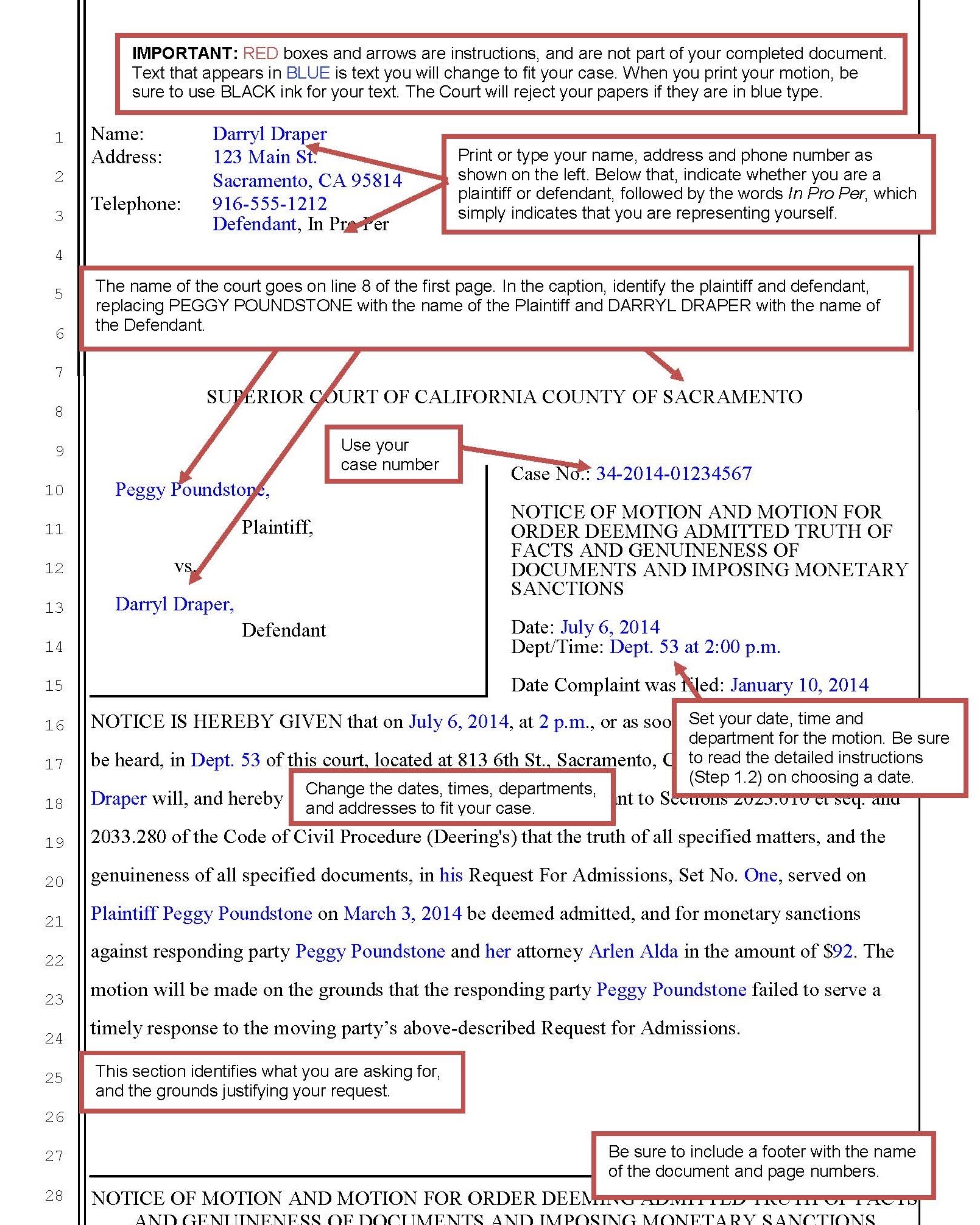
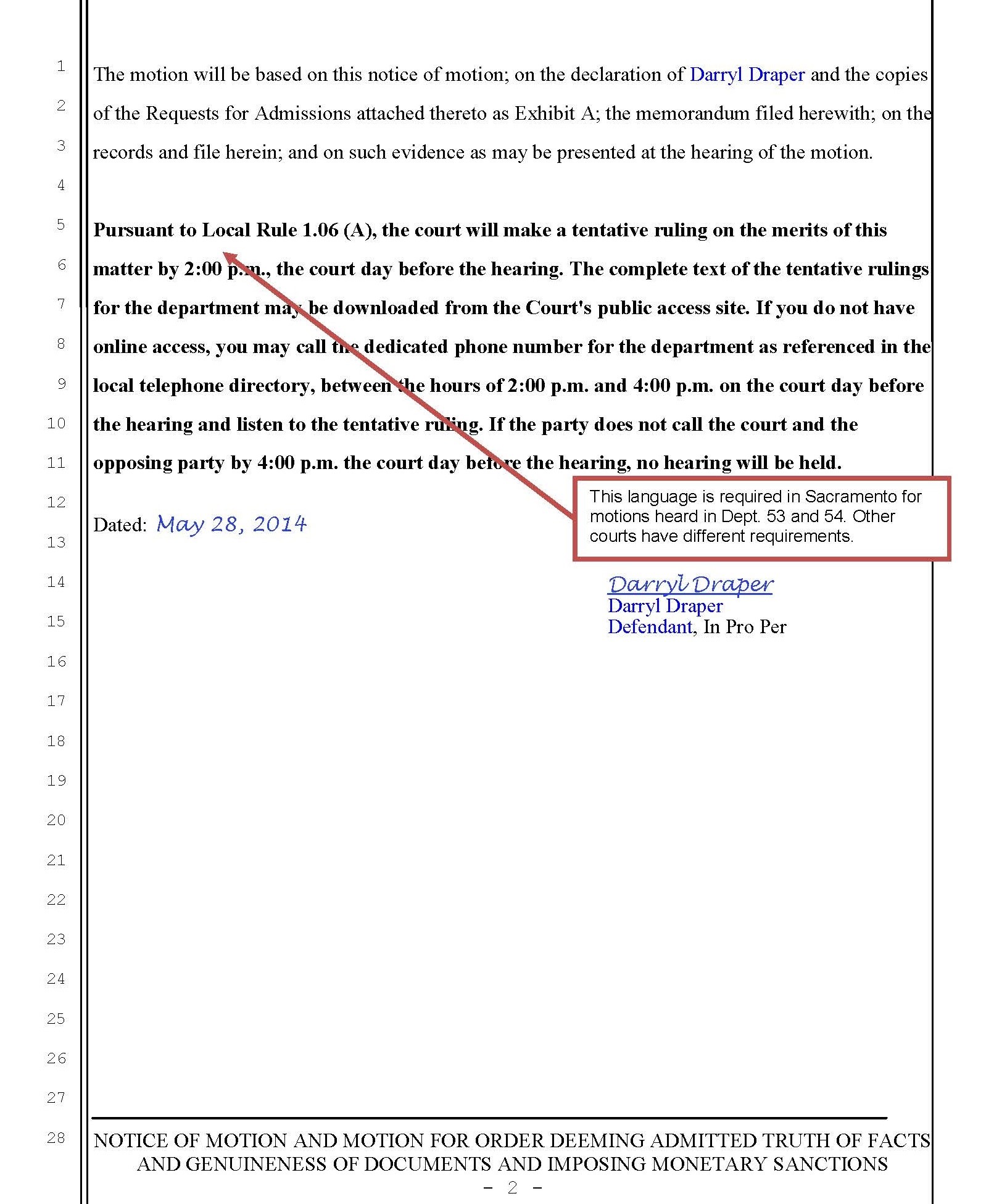
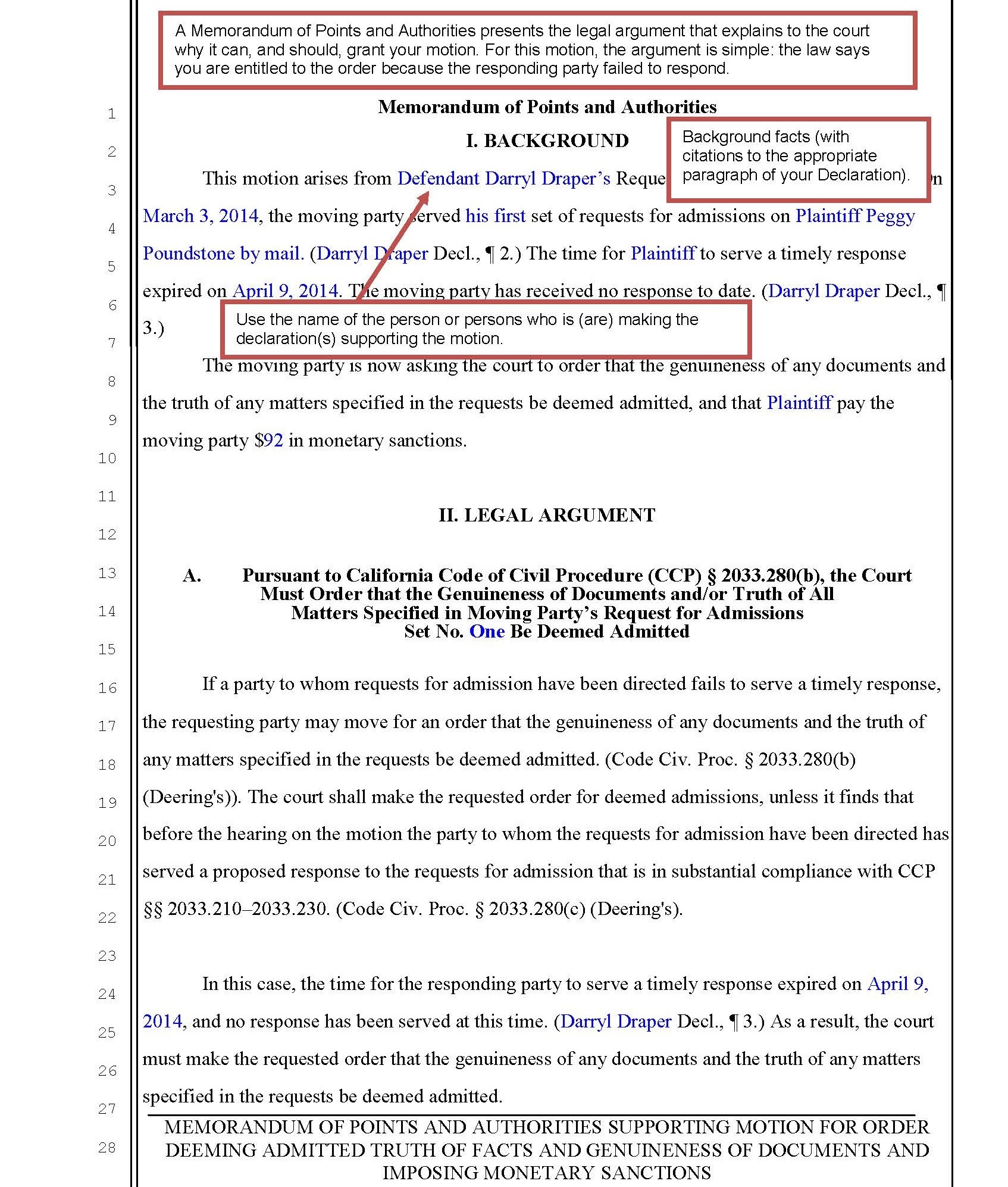
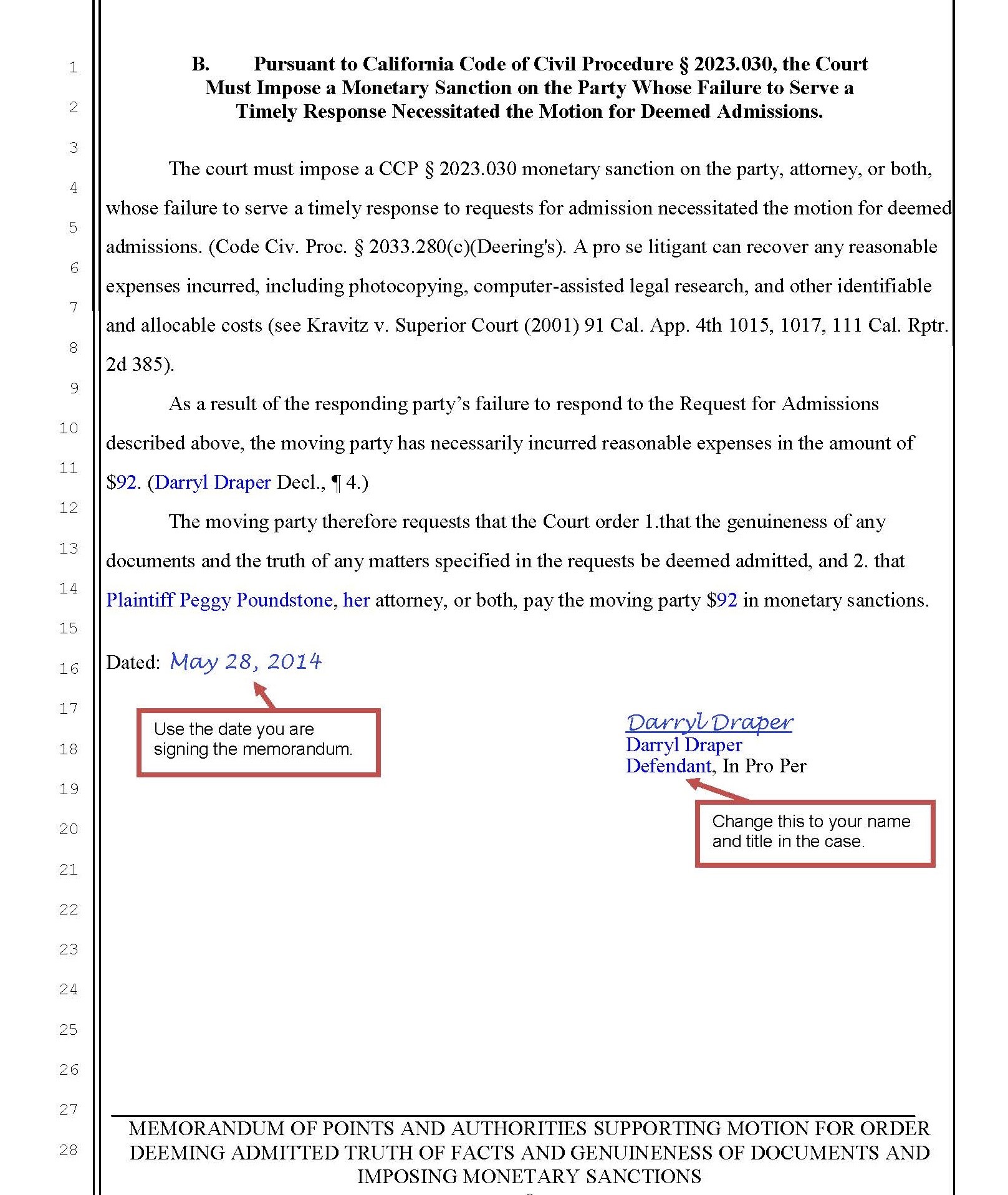
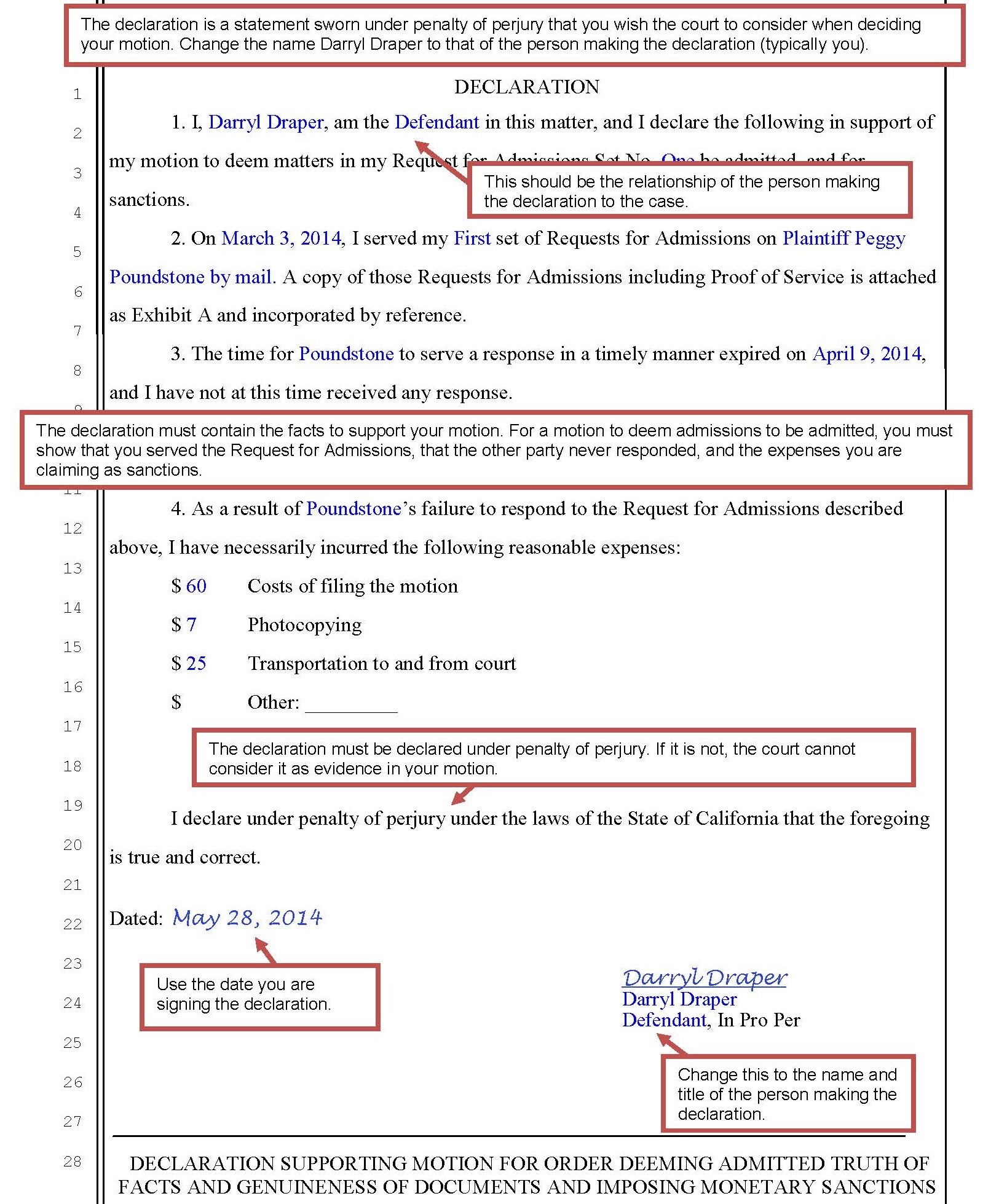
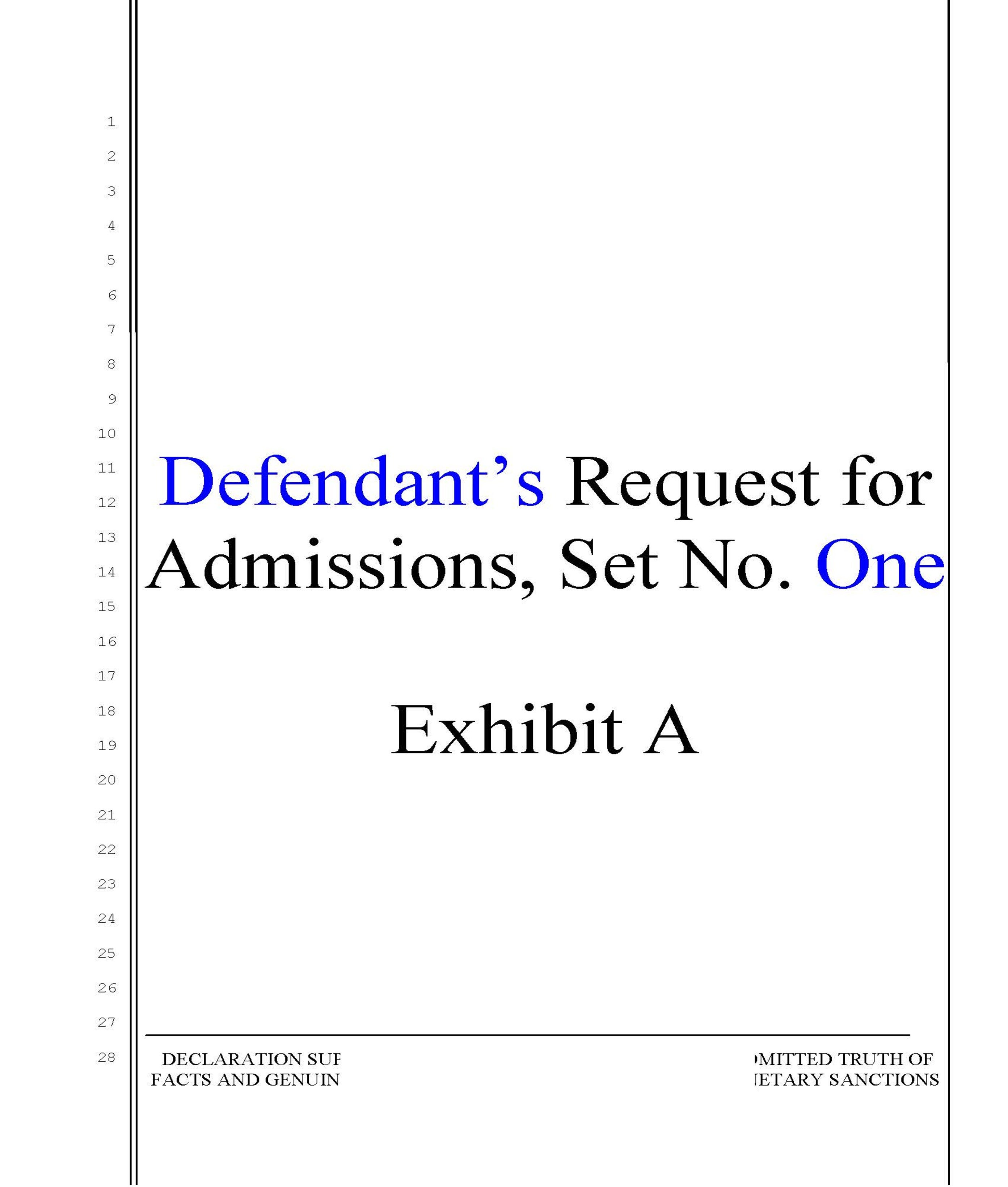
This material is intended as general information only. Your case may have factors requiring different procedures or forms. The information and instructions are provided for use in the Sacramento County Superior Court. Please keep in mind that each court may have different requirements. If you need further assistance consult a lawyer.




